Congratulations on taking the exciting step towards launching your online course! Whether you’re a seasoned educator or venturing into the world of online teaching for the first time, careful planning is essential for success.
Unfortunately, many course creators overlook fundamental aspects or approach the process in the wrong sequence, which could lead to poorly structured courses, diminished enrollment rates, wasted time, or missed revenue opportunities.
To ensure that your online course reaches its full potential, it’s crucial to maintain organization throughout the planning and launch phases. That’s where this article comes in handy.
We’ve crafted a comprehensive checklist, meticulously designed to guide you through each stage of the journey: from initial planning to successful promotion.
As you progress through each stage of launching your online course, simply check off the corresponding points on this checklist. This visual aid will help you stay on track and ensure that no crucial step is missed along the way.
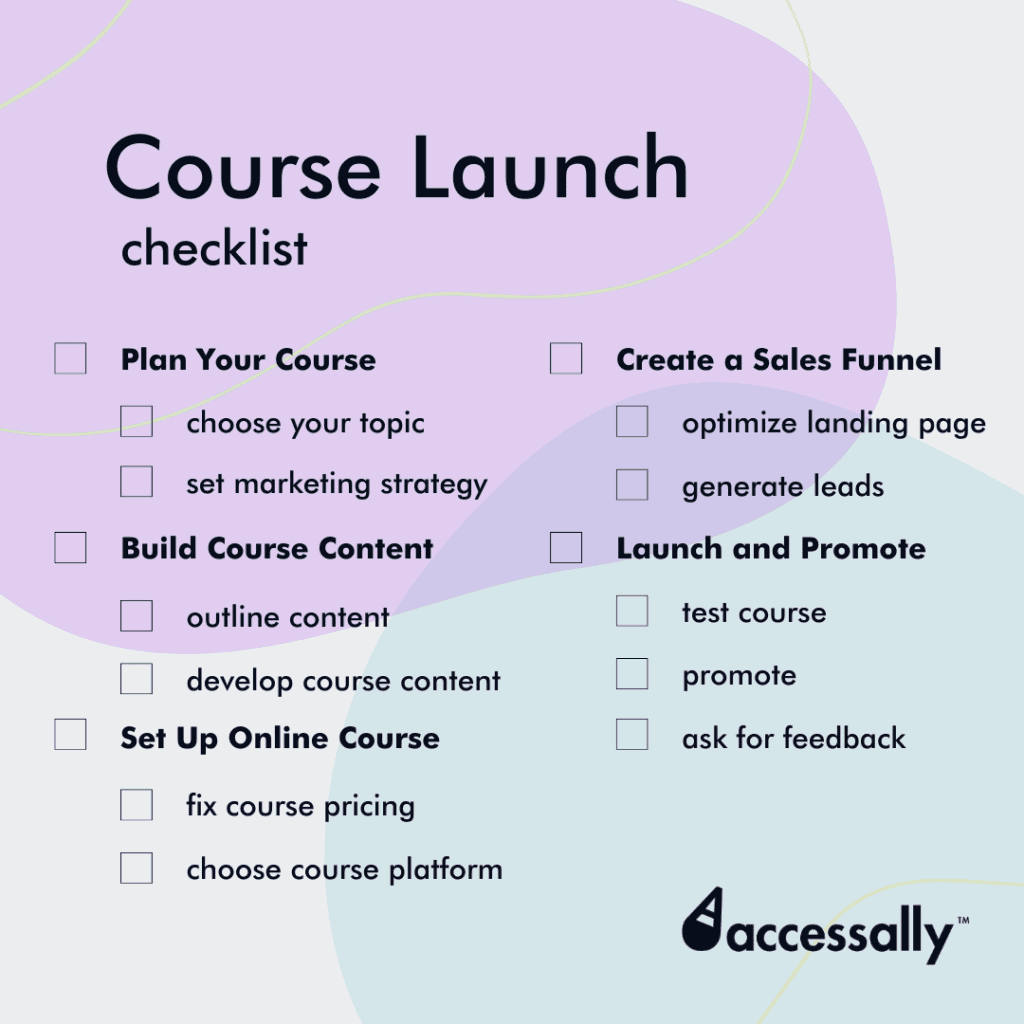

Planning Your Online Course
In this crucial stage, you’ll lay the foundation for your online course, ensuring that all elements are aligned right from the start. Investing time in these foundational aspects will pave the way for long-term success.
Choose Your Topic
If you’re considering launching an online course, it’s likely because you possess expertise in a particular subject. But just having a passion for something doesn’t automatically translate to a successful course.
Here’s how to ensure your topic resonates with your audience:
- Conduct Market Research to Validate Demand: Understand if there’s a market need for your course by analyzing keywords, search volume, and related trends.
- Analyze Competitors and Market Trends: Study existing courses in your niche to identify gaps and opportunities. Stay updated on industry trends to position your course effectively.
- Define Target Audience: Clearly identify who your course is for, including demographics, interests, and pain points.
- Collect Data on Your Target Audience: Gather insights through surveys, interviews, or social media interactions to understand your audience’s preferences and needs.
- Define Course Topic Angle: Determine the unique angle or perspective you’ll take with your course to cater to the demand effectively. Decide whether you’ll target beginners, intermediate learners, or advanced students.
Begin Crafting Your Marketing Strategy
As you define your course topic and target audience, it’s crucial to start shaping your marketing strategy. Your marketing efforts should align with your course objectives and resonate with your potential students.
- Define Marketing Objectives: Establish clear objectives for your marketing efforts, such as enrollment targets or revenue goals. Determine how you’ll measure success, whether through conversion rates, engagement metrics, or revenue generated.
- Develop Messaging: Tailor your messaging based on your target audience’s interests, pain points, and aspirations. Craft compelling language that resonates with your audience and communicates the value proposition of your course.
- Identify Effective Promotional Channels: Choose the marketing channels that are most likely to reach your target audience. Whether it’s social media, email marketing, content marketing, or paid advertising, select channels that align with your audience’s preferences and behavior.
For further insights on crafting an effective marketing strategy for your online course, check out our comprehensive guide here.
Meticulously planning your online course and developing a robust marketing strategy will set you up for success in the competitive landscape of online education.


Building Your Course Content
The core of the course creation process is building your course content. Exceptional content is the cornerstone of a successful online course, captivating students and driving engagement.
Create The Outline of Your Course
Before diving into content creation, it’s essential to construct a solid outline for your online course. This roadmap will guide you through the development process and ensure coherence and effectiveness in delivering your material.
Constructing your course outline involves the following steps:
- Choose Course Name: Select a catchy and descriptive name that reflects the essence of your course and captures the attention of potential students.
- Set Learning Objectives: Clearly define what students will achieve by the end of the course. Establishing specific, measurable learning objectives helps align your content with desired outcomes.
- Develop a Structured Course Outline: Break down your course into manageable modules, delineating the milestones students will progress through. Within each module, specify:
- The number of modules — milestones students will pass through
- The number of lessons in each module
- and the type of assessments used to evaluate students’ progress.
Outlining your course in this way will give you a comprehensive overview of the content flow and can ensure that each component contributes to the overall learning experience.
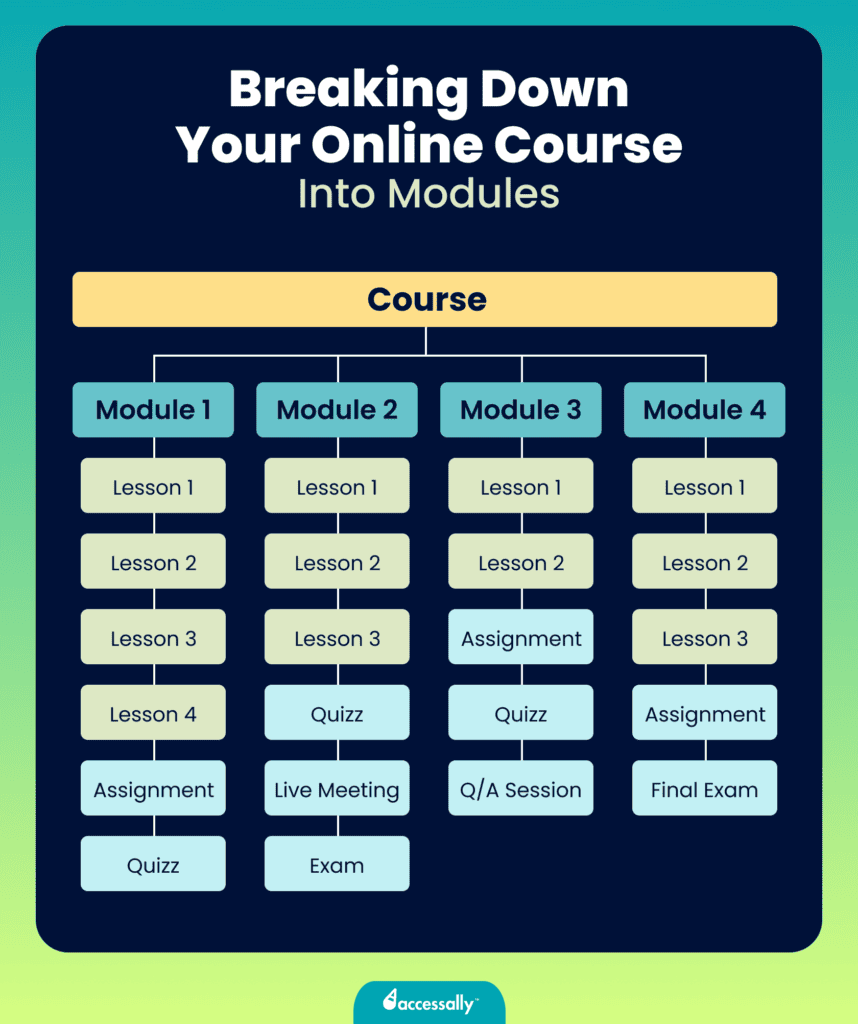

Develop Your Course Content
Creating the content for your online course is a significant undertaking and often one of the most time-consuming stages of the process. The complexity of this step varies depending on the nature of your course and the depth of content you aim to deliver.
Whether you’re developing simple written materials or professional-quality videos and animations, the course outline you established earlier will guide you through this phase.
Here’s how to approach developing your course content:
- Allocate Time for Content Creation Based on Complexity: Assess the scope and complexity of your course content to determine how much time you’ll need for creation. Factor in tasks such as writing, designing, filming, editing, and any other content-related activities.
- Create Course Content: Begin the creation process by writing, designing, and/or filming the materials outlined in your course structure. This may involve preparing written documents, recording video lectures, designing graphics or animations, and developing interactive elements.
- Hire Outside Help When Needed: Depending on your skills and resources, consider outsourcing certain tasks to professionals to ensure high-quality content production. This may include hiring copywriters for written content, graphic designers for visuals, video editors for video production, audio editors for podcast-style content, developers for interactive features, animators for animations, and voice-over artists for narration.
- Review and Edit Course Content: Once the initial content is created, thoroughly review and edit each component to ensure accuracy, clarity, and alignment with your learning objectives. Solicit feedback from peers or beta testers if possible to identify areas for improvement.
By following these steps and leveraging external expertise when necessary, you’ll be able to develop engaging and high-quality content that resonates with your audience and enhances their learning experience.
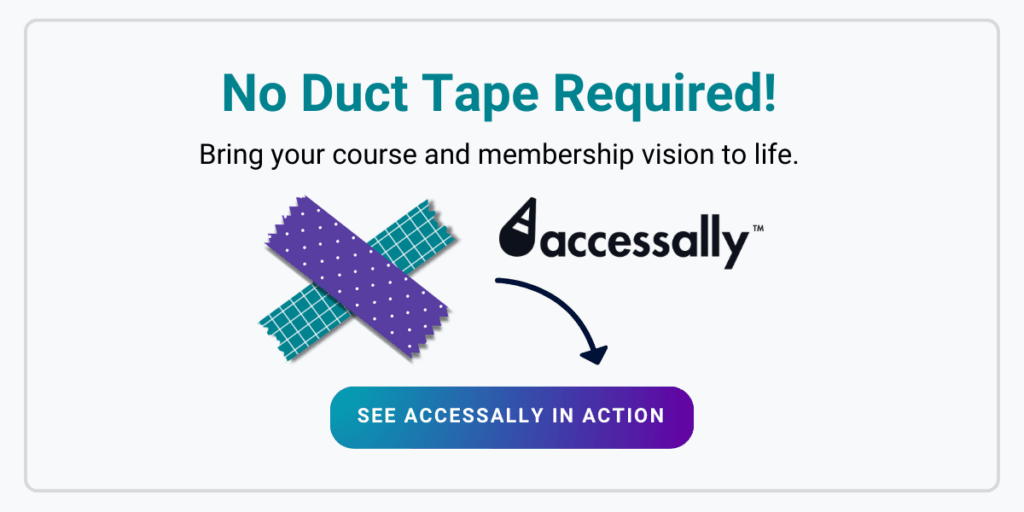

Setting Up Your Online Course
In this section, we address crucial decisions that can significantly impact the success of your online course from a business standpoint, such as pricing strategy and choosing the right platform.
Fix Your Price
Setting the price for your online course is a critical decision that requires careful consideration. Your pricing should reflect the value of your course and compensate for your investment of time and resources.
This step should be taken with careful consideration because there are risks associated with making the wrong decision:
- Charging too little: devalues your course and limit revenue potential
- Charging too much: could force you to reduce your price in order to make more sales (bad practice).
Here’s how to determine the optimal price:
- Evaluate Your Course Quality and Expertise Level: Consider the depth of content, level of expertise, and unique value proposition of your course.
- Consider Competitor Pricing and Market Demand: Research similar courses in your niche to understand prevailing price points and assess market demand.
- Consider Target Students’ Financial Capabilities: Take into account the financial capabilities of your target audience to ensure your pricing is accessible yet profitable.
- Take Into Account Your Time and Monetary Investment: Factor in the time and resources invested in creating your course to ensure your pricing is sustainable and reflects your effort.
Choosing the right price is essential for maintaining the perceived value of your course and maximizing revenue potential.
Choose Your Platform
Selecting the appropriate platform to host and sell your online course is vital to its success. Different platforms cater to varying needs and stages of growth for course creators.
We’ve created this decision chart to help you determine which platform might be best for you:
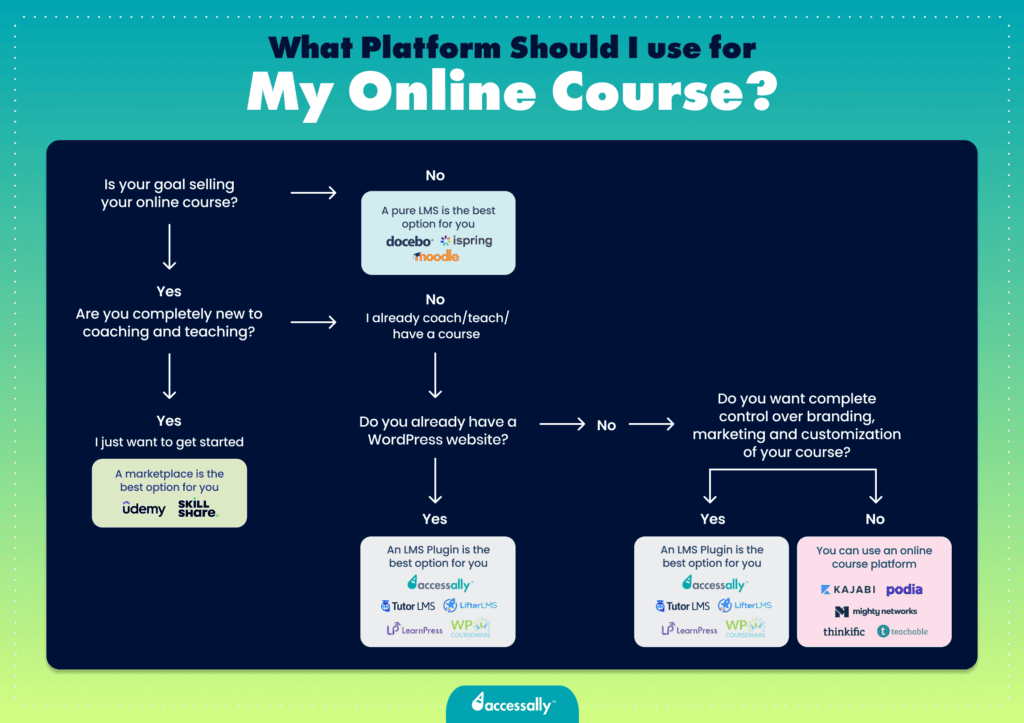

- Research the Different Course Platforms Available: Explore the features and capabilities of different platforms, including course marketplaces, online course platforms, and Learning Management System (LMS) plugins.
- Assess Your Business Goals: Determine your business objectives and how the chosen platform aligns with them in terms of scalability, customization, and marketing support.
- Consider Scalability: Choose a platform that can grow with your business and accommodate increasing course enrollments and offerings.
- Evaluate Ease of Setup, Marketing Support, and Customization Options: Assess the platform’s user-friendliness, available marketing tools, and customization options to ensure it meets your needs.
- Compare Pricing and Fees: Compare the pricing structures and fees of different platforms to find one that offers the best value for your investment.
- Select Your Platform and Sign Up for an Account: Once you’ve evaluated your options, choose the platform that best suits your requirements and create an account.
- Complete Course Setup: Customize your course settings, set up payment processing, and upload your course content to make it available to your audience.
Choosing the right platform is crucial for providing a seamless learning experience and effectively monetizing your course content.
Creating Your Online Course Sales Funnel
Before launching your online course, it’s crucial to set up your sales funnel to attract potential students and convert them into customers. Focus on optimizing your landing page and generating leads to ensure a successful course launch.
Optimize your landing page
Your course landing page plays a vital role in converting website visitors into leads or customers. If you are creating your online course on your website, you will also need to set up a course landing page or sales page. If you do not have a website and have chosen to opt for creating your course on a course marketplace, you can ignore this step.
Your course landing page is a page on your website that is dedicated to selling your course; the goal is to convert website visitors into leads or customers.
- Create a Dedicated Webpage: Design a dedicated webpage on your website or platform specifically for promoting your course.
- Write a Strong Headline: Craft a compelling headline that grabs attention and clearly communicates the value proposition of your course.
- Write a Course Description: Provide detailed information about your course, including its content, target audience, and expected outcomes.
- Include a Call to Action: Add a prominent call-to-action button that encourages visitors to enroll in your course, using persuasive language such as “enroll now” or “sign up.”
- Showcase Student Testimonials: Display testimonials from satisfied students to build credibility and trust.
- Add FAQs: Address common questions and concerns about enrolling in your course to alleviate any doubts potential students may have.
- Include Pricing Options: Clearly outline the pricing details and different pricing tiers, if applicable, to help visitors make informed decisions.
- Add a Satisfaction Guarantee: Offer a satisfaction guarantee to reassure potential students and remove any barriers to enrollment.
- Display Your Teacher Bio and Story: Share your credentials, expertise, and passion for the subject matter to establish credibility and connect with potential students.
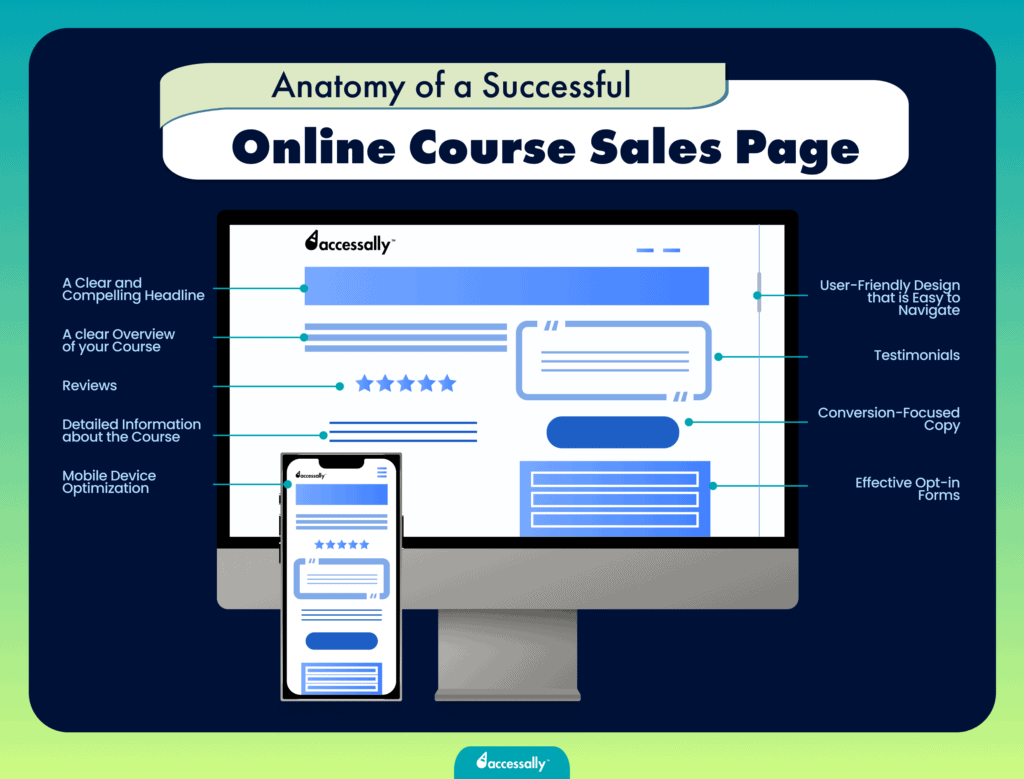

Generate Leads
Now that your landing page is optimized, it’s time to drive traffic to it and generate leads for your course. You’ll leverage marketing channels you identified during your strategy phase to funnel traffic to your website.
- Use various marketing channels to drive traffic to your landing page: such as social media ads, paid search ads, blog posts, and email marketing to funnel traffic to your landing page.
- Consider offering a lead magnet, such as a free valuable resource related to your course topic, to incentivize visitors to join your email list. This could be a mini-course, e-book, video tutorial, or template.
By implementing these strategies, you’ll attract potential students to your course and build a solid foundation for a successful launch.
Launch and Promotion
In this final section, we focus on the crucial steps required during the immediate pre- and post-launch period to ensure a smooth launch and long-term success for your online course.
Test Your Course
Before launching your course, it’s essential to personally test it to identify and resolve any potential technical issues. It’s a good idea to ask a group of beta students (paid or free) to test your course at this point to identify any problems.
- Test Student Enrollment Process: Ensure that the enrollment process for your course functions smoothly without any hiccups.
- Test Coupon Functionality (if applicable): If you’re offering discounts or promotions, test the coupon functionality to ensure it works correctly.
- Ensure Content is Clear: Review all course content to ensure it is clear, concise, and error-free.
- Evaluate the Overall User Experience: Put yourself in the shoes of your students and assess the overall user experience of your course, from navigation to accessibility.
Promote Course Launch
Now that your course is ready to launch, it’s time to promote it to your target audience:
- Announce the Launch to Your Email List: Send out an email to your subscribers informing them about the launch of your course and inviting them to enroll.
- Offer Special Discounts or Promotions: Encourage enrollment by offering limited-time discounts or promotions associated with the launch.
- Consider Partnering with Relevant Businesses or Influencers: Collaborate with businesses or influencers in your niche to extend your reach and attract more students.
Ask for Student Feedback
Once the first set of students have been through your course, you’ll want to collect feedback. Feedback from your students is invaluable for improving and refining your course content. Here’s how to gather and utilize student feedback effectively:
- Ask for Student Feedback: Encourage your students to provide feedback on their learning experience, course content, and any areas for improvement.
- Identify Potential Areas for Improvement: Use the feedback received to identify potential areas for improvement and make necessary adjustments to your course.
- Enable Student Reviews: Allow students to leave reviews and ratings for your course to build credibility and attract more enrollments.
- Add Strong Student Testimonials to Your Landing Page: Incorporate positive testimonials from satisfied students on your landing page to showcase the value of your course.
- Share Student Testimonials on Your Marketing Channels: Use student testimonials in your marketing efforts to highlight the benefits of enrolling in your course and attract more potential students.
By following these steps, you’ll not only ensure a successful launch but also lay the foundation for continuous improvement and refinement of your online course.





